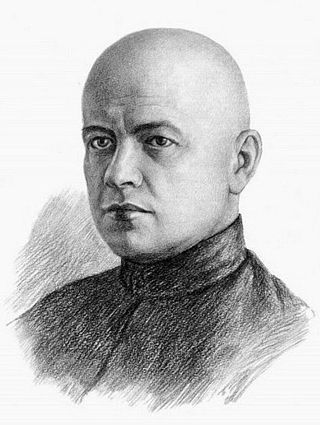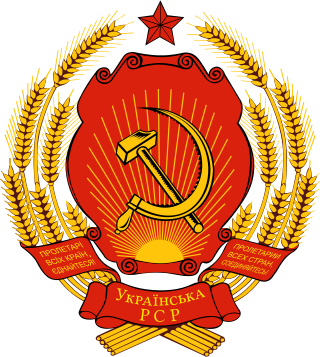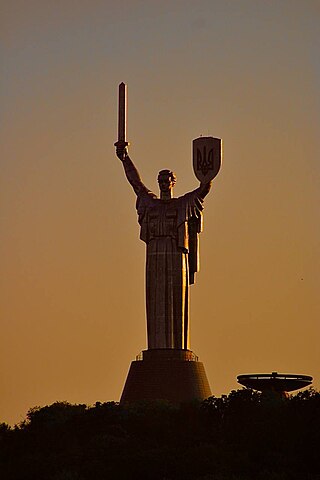
Stanisław Vikentyevich Kosior, sometimes spelled Kossior, was a Soviet politician who was First Secretary of the Communist Party of Ukraine, Deputy Premier of the Soviet Union and member of the Politburo of the Communist Party of the Soviet Union (CPSU). He and his wife were both executed during the Great Purge.

Yevgeny Viktorovich Vuchetich was a prominent Soviet sculptor and artist. He is known for his heroic monuments, often of allegoric style, including The Motherland Calls, the largest sculpture in the world at the time.

The Muzeon Park of Arts is a park outside the Krymsky Val building in Moscow shared by the modern-art division of the Tretyakov Gallery and the Central House of Artists. It is located between the Park Kultury and the Oktyabrskaya underground stations. The largest open-air sculpture museum in Russia, it has over 1,000 artworks currently in its collection.

The Statue of Lenin is a 16 ft (5 m) bronze statue of Russian communist revolutionary Vladimir Lenin in the Fremont neighborhood of Seattle, Washington, United States. It was created by Bulgarian-born Slovak sculptor Emil Venkov and initially put on display in the Czechoslovak Socialist Republic in 1988, the year before the Velvet Revolution. After the dissolution of the Soviet Union, a wave of de-Leninization brought about the fall of many monuments in the former Soviet sphere. In 1993, the statue was bought by an American who had found it lying in a scrapyard. He brought it home with him to Washington State but died before he could carry out his plans to formally display it.

The Stalin Monument was a statue of Joseph Stalin in Budapest, Hungary. Completed in December 1951 as a "gift to Joseph Stalin from the Hungarians on his seventieth birthday", it was torn down on October 23, 1956, by enraged anti-Soviet crowds during Hungary's October Revolution.

Grigory Ivanovich Petrovsky was a Ukrainian Soviet politician and Old Bolshevik. He participated in signing the Treaty on the Creation of the Union of Soviet Socialist Republics and the Treaty of Brest-Litovsk. Petrovsky was Communist Party leader in Ukraine until 1938, and one of the officials responsible for implementing Stalin's policy of collectivization.

The Communist Party of Ukraine was the founding and ruling political party of the Ukrainian SSR operated as a republican branch of the Communist Party of the Soviet Union (CPSU).

Mother Ukraine is a monumental Soviet-era statue in Kyiv, the capital of Ukraine. The sculpture is a part of the National Museum of the History of Ukraine in the Second World War. In 2023, the Soviet heraldry was removed from the monument's shield and replaced with Ukraine's coat of arms, the tryzub.

Lev Yefimovich Kerbel was a Soviet and Russian sculptor of socialist realist works. Kerbel's creations included statues of Karl Marx, Vladimir Lenin, Yuri Gagarin, which were sent by Soviet Government as gifts to socialist and the Third World countries across the world.

Memento Park is an open-air museum in Budapest, Hungary, dedicated to monumental statues and sculpted plaques from Hungary's Communist period (1949–1989). There are statues of Lenin, Marx, and Engels, as well as several Hungarian Communist leaders. The park was designed by Hungarian architect Ákos Eleőd, who won the competition announced by the Budapest General Assembly in 1991. On public transport diagrams and other documents the park is usually shown as Memorial Park.

Matvey Genrikhovich Manizer was a prominent Russian sculptor. Manizer created a number of works that became classics of socialist realism.

Joseph Stalin's cult of personality became a prominent feature of Soviet popular culture. Historian Archie Brown sets the celebration of Stalin's 50th birthday on 21 December 1929 as the starting point for his cult of personality. For the rest of Stalin's rule, the Soviet propaganda presented Stalin as an all-powerful, all-knowing leader, with Stalin's name and image appearing everywhere.

The Vladimir Lenin monument in Kyiv was a statue dedicated to Vladimir Lenin, the founder of the Soviet Union in Kyiv, the capital of Ukraine. The larger than life-size Lenin monument was built by Russian sculptor Sergey Merkurov from the same red Karelian stone as Lenin's Mausoleum. It was displayed at the 1939 New York World's Fair and erected on Kyiv's main Khreshchatyk Street on 5 December 1946.
De-Stalinization comprised a series of political reforms in the Soviet Union after the death of long-time leader Joseph Stalin in 1953, and the thaw brought about by ascension of Nikita Khrushchev to power, and his 1956 secret speech "On the Cult of Personality and Its Consequences", which denounced Stalin's cult of personality and the Stalinist political system.
Decommunization in Ukraine started during the dissolution of the Soviet Union in 1991 and expanded afterwards. Following the 2014 Revolution of Dignity and beginning of the Russo-Ukrainian War, the Ukrainian government approved laws that banned communist symbols, as well as symbols of Nazism as ideologies deemed to be totalitarian. Along with derussification in Ukraine, it is one of the two main components of decolonization in Ukraine.

The demolition of monuments to Vladimir Lenin in Ukraine started during the fall of the Soviet Union and continued to a small extent throughout the 1990s, mostly in some western Ukrainian towns, though by 2013 most Lenin statues in Ukraine remained standing. During Euromaidan in 2013–2014, the destruction of statues of Lenin become a widespread phenomenon and became popularly known in Ukraine as Leninopad, a pun literally translated as "Leninfall", with the coinage of "-пад" being akin to English words suffixed with "fall" as in "waterfall", "snowfall", etc.

























